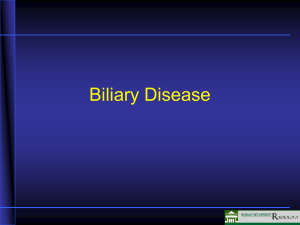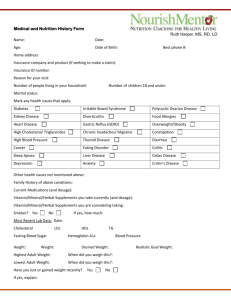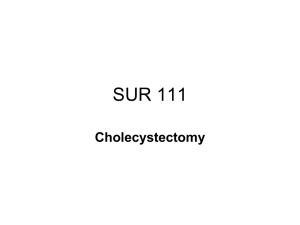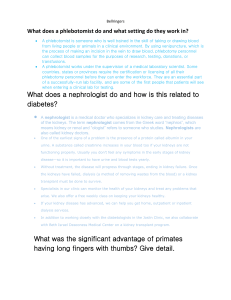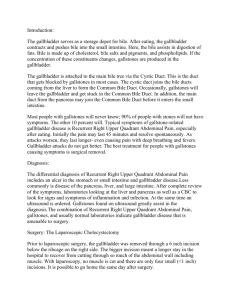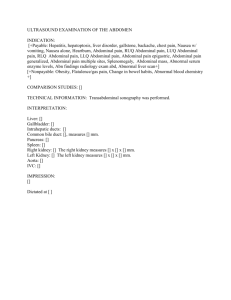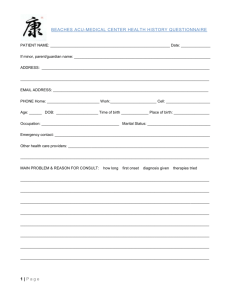UNWANTED STONES: KIDNEY AND GALLSTONES
advertisement
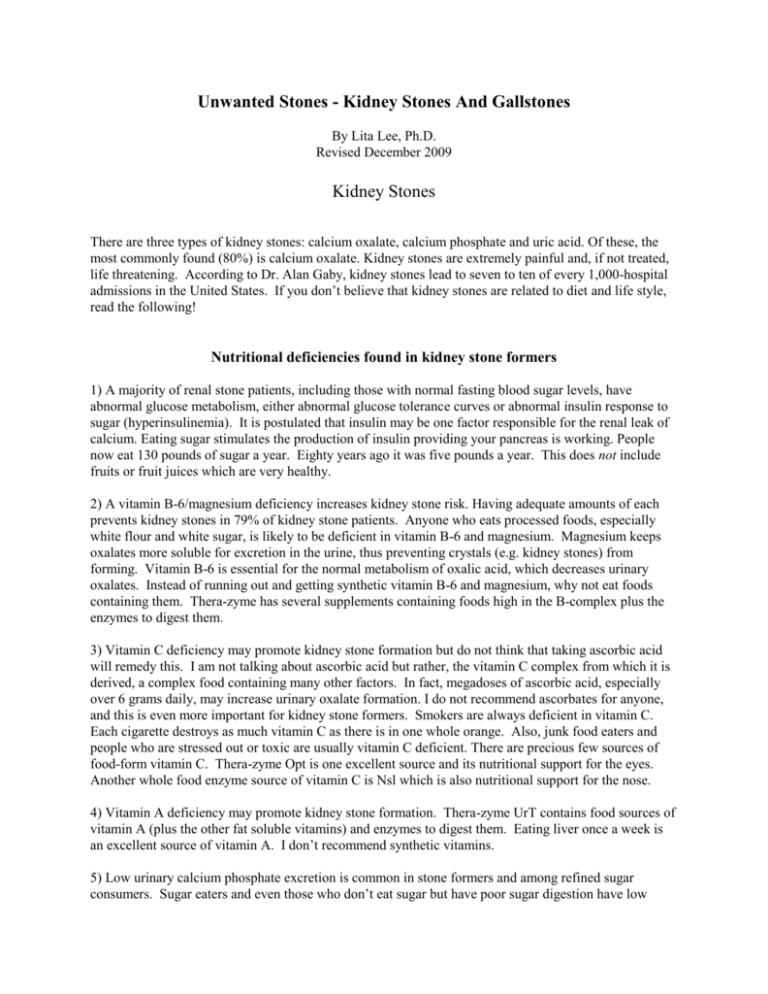
Unwanted Stones - Kidney Stones And Gallstones By Lita Lee, Ph.D. Revised December 2009 Kidney Stones There are three types of kidney stones: calcium oxalate, calcium phosphate and uric acid. Of these, the most commonly found (80%) is calcium oxalate. Kidney stones are extremely painful and, if not treated, life threatening. According to Dr. Alan Gaby, kidney stones lead to seven to ten of every 1,000-hospital admissions in the United States. If you don’t believe that kidney stones are related to diet and life style, read the following! Nutritional deficiencies found in kidney stone formers 1) A majority of renal stone patients, including those with normal fasting blood sugar levels, have abnormal glucose metabolism, either abnormal glucose tolerance curves or abnormal insulin response to sugar (hyperinsulinemia). It is postulated that insulin may be one factor responsible for the renal leak of calcium. Eating sugar stimulates the production of insulin providing your pancreas is working. People now eat 130 pounds of sugar a year. Eighty years ago it was five pounds a year. This does not include fruits or fruit juices which are very healthy. 2) A vitamin B-6/magnesium deficiency increases kidney stone risk. Having adequate amounts of each prevents kidney stones in 79% of kidney stone patients. Anyone who eats processed foods, especially white flour and white sugar, is likely to be deficient in vitamin B-6 and magnesium. Magnesium keeps oxalates more soluble for excretion in the urine, thus preventing crystals (e.g. kidney stones) from forming. Vitamin B-6 is essential for the normal metabolism of oxalic acid, which decreases urinary oxalates. Instead of running out and getting synthetic vitamin B-6 and magnesium, why not eat foods containing them. Thera-zyme has several supplements containing foods high in the B-complex plus the enzymes to digest them. 3) Vitamin C deficiency may promote kidney stone formation but do not think that taking ascorbic acid will remedy this. I am not talking about ascorbic acid but rather, the vitamin C complex from which it is derived, a complex food containing many other factors. In fact, megadoses of ascorbic acid, especially over 6 grams daily, may increase urinary oxalate formation. I do not recommend ascorbates for anyone, and this is even more important for kidney stone formers. Smokers are always deficient in vitamin C. Each cigarette destroys as much vitamin C as there is in one whole orange. Also, junk food eaters and people who are stressed out or toxic are usually vitamin C deficient. There are precious few sources of food-form vitamin C. Thera-zyme Opt is one excellent source and its nutritional support for the eyes. Another whole food enzyme source of vitamin C is Nsl which is also nutritional support for the nose. 4) Vitamin A deficiency may promote kidney stone formation. Thera-zyme UrT contains food sources of vitamin A (plus the other fat soluble vitamins) and enzymes to digest them. Eating liver once a week is an excellent source of vitamin A. I don’t recommend synthetic vitamins. 5) Low urinary calcium phosphate excretion is common in stone formers and among refined sugar consumers. Sugar eaters and even those who don’t eat sugar but have poor sugar digestion have low 2 phosphorus because phosphorus is required in sugar metabolism. You can detect this in a 24-hour urine because the sediment is always abnormally low in calcium phosphate, a normal product of carbohydrate metabolism. The blood will be normal to maintain homeostasis but it cannot spare the normal (threshhold) amount of calcium phosphate that should be observed in the urine. 6) Low fiber diets increase risk to kidney stone formation. The all-American diet of meat, fat and sugar with its zero% fiber, is a prescription for kidney stones. But I do not recommend isolated fibers but instead to eat whole organic foods that naturally contain fibers. Conditions which affect kidney stone formation 1) Urinary calcium excretion is more pronounced in stone formers than non-stone formers. 2) Cadmium is a very toxic heavy metal whose target organ is the kidneys. There are many references to document the causal connection of cadmium and kidney stones. Cadmium causes renal tubular damage and may encourage oxalate crystallization (Werbach). Increased blood cadmium, common in smokers, increases risk to kidney stones by 40% compared to 3.5% in the control group (Werbach). If you are a runner, don’t jog along the highway. This is the best place to get cadmium (from automobile pollution). 3) Optimizing urine/blood pH helps decrease risk to kidney stone formation. Plant enzyme therapy is the only method I have observed that will correct a deviation in physiology, including the acid/base balance of the body. Why? The blood creates its own acid-base balance from the acidity and alkalinity provided from the digestion of food along with the proper ratios of water, carbon dioxide and oxygen. Everybody drinks water and breathes (we hope!) but not everybody eats an organic, whole food, prothyroid diet. This makes plant enzyme therapy of utmost importance in balancing body chemistry. The urinary oxalate-kidney stone connection The ingestion of high-oxalate foods (containing 25 mg/100 gm oxalate) may not be related to kidney stone formation. In fact, only 16.3 % of 392 stone formers were found to have excess urinary oxalates (Werbach). It has been also observed that dietary oxalate increases urinary oxalates by a relatively small amount. I am emphasizing this because there are many excellent high oxalate foods, such as beet tops, carrots, celery, cucumber, kale, parsley, rhubarb, spinach, and sweet potato. Please, do not think you need to eliminate these foods from your diet. Instead, correct your nutritional imbalances. Enzyme Support for Kidney Stones According to Dr. Loomis All stone formers need Thera-zyme UrT containing foods high in vitamin A plus its fat-soluble vitamin partners (D, E, F, etc.); vitamin C (not ascorbic acid); minerals, especially calcium, magnesium and potassium; and protein, plus the enzymes to digest it. The foods in this formula include alfalfa juice, buchu leaf, horsetail rush, cranberry, hydrangea, meadowsweet, uva ursi plus enzymes. Notice that this formula contains food sources of ALL the nutritional deficiencies found in kidney stone formers! Only those who have suffered the pain of kidney stones can appreciate that, in some cases in which the stone is not large, this pain is eliminated sometimes overnight. In other cases requiring medical attendance, Thera-zyme UrT is still indicated to prevent further occurrences. There are specific tests that determine the need for this formula. 3 If I see a trace of blood in the urine that does NOT disappear in two weeks of taking Thera-zyme UrT, I suspect the client has kidney stones. However, the only way to diagnose their presence is with a medical test. If the kidneys appear sore and stressed (low volume, low specific gravity), Thera-zyme Kdy will provide nutritional support to relieve this condition. This formula relieves kidney stress, removes excess water from the tissues and has many other nutrient uses not relevant to kidney stones! It’s easier to analyze the urine sediment for these substances than to wait until you have a kidney stone, excrete it, cut it out, smash it, analyze it and then figure out what to do. Gallstones Twenty million Americans have gallstones and these increases by one million more annually. Each year in the U.S., more than 300,000 gallbladders are removed due to gallbladder disease. Gallstones are comprised of precipitated (crystallized) components of bile, mainly pure cholesterol, plus various amounts of bile pigment (calcium bilirubinate), and calcium salts. Approximately 80% of the U.S. stones are mixed. The rest are mainly calcium salts, although some stones contain silicon and aluminum oxides. For references, please consult any book on pathology or internal medicine. The greatest hormone-related cause of gallstones is estrogen, including the estrogen dominance of hypothyroidism, birth control pills and estrogen replacement therapy, which is probably why six times as many women as men get gallstones. Also, cholesterol-lowering drugs increase the risk of gallstones by increasing cholesterol secretion in the bile. Although gallstones have been found in the fetus and in the elderly, the incidence increases with age, and the average patient is 40-50 years old. The enzyme connection to gallstones is fat intolerance (lipase deficiency) - the inability to adequately digest fat. And the worst fats are the PUFA, polyunsaturated fatty acids (omega-3 and -6 oils). Because gallstones are easier to prevent than to reverse, let’s talk about prevention! The gallbladder is a little sac that stores and concentrates bile produced by the liver. During digestion, the gallbladder contracts and supplies bile to the small intestine via the common bile duct. In a normal healthy person, the liver converts cholesterol to bile acids (about 1/2 gram daily) to replace the loss of bile acids in the feces. Bile is an aqueous solution containing mainly bile salts plus smaller amounts of bilirubin, cholesterol, fatty acids, lecithin and alkaline minerals (sodium, potassium and calcium). Ultimately, all cholesterol that is excreted must enter the liver and be excreted in the bile as bile salts or as cholesterol. Bile salts have two very important functions. They have a “detergent function” - they emulsify fats. They also facilitate absorption of fatty acids, monoglycerides, cholesterol and other lipids from the intestinal tract. Without bile salts, up to 40% of the fats are lost in the stool. This causes a deficiency of nutrient fats and the fat-soluble vitamins (A, D, E, F, K). Gallstones are formed when cholesterol precipitates due to a decrease in bile salts, an increase in the bile salts, an increase in the amount of cholesterol in the bile (increased bile saturation index), a decrease in water or increased acidity. All of these factors must be just right to keep the highly insoluble cholesterol in solution. Because bile is formed from cholesterol in the liver, a healthy liver is essential to gallbladder 4 health. Any substance that inhibits bile formation from cholesterol or decreases its solubility in the bile is a risk factor. The higher the bile saturation index, the greater the percentage of cholesterol in the bile and the greater the risk of gallstones. Although gallstones are the fifth most prevalent cause of hospitalization in America, not everyone with gallbladder problems is acute. Silent gallstones are very common. It may take as long as eight years to produce a “noisy” one. Some of the many lesser chronic symptoms include: belching after meals, pain between the shoulder blades, a sour taste in the mouth or indigestion, a feeling of bloating, abdominal discomfort, intolerance of fatty/greasy or spicy foods, clay-colored stools (indicating a lack of adequate bile), bilious headaches, vertigo, and skin problems (due to inadequate fat absorption). Noisy gallstones produce acute symptoms which includes severe pain under the right rib cage that radiates around to the right shoulder and under the shoulder blade, with possible nausea and vomiting, especially after a high fat, spicy or heavy meal. When this progresses, the liver, unable to process bilirubin adequately, dumps it into the urine and into the blood causing jaundice. Although it may save your life, gallbladder removal does not correct the cause - fat intolerance (lipase deficiency) and the liver’s inability to convert cholesterol to bile. Fiber, Sugar and Gallstones The American processed, junk food diet high in meat, fat, refined carbohydrates (sugars) and low in fiber has been correlated with increased incidence of gallstones. A high roughage (fiber) diet can only be achieved with whole unprocessed, unrefined foods. We need 24-25 grams of fiber daily. The America diet provides 6-8 grams daily. A high fiber diet protects us from gallbladder disease as well as colorectal cancer, heart disease, diabetes and diverticular disease. Fiber binds cholesterol and bile salts, decreasing intestinal transit time and preventing intestinal bacteria from converting bile salts into carcinogens. In experimental studies, people who added fiber to their diet had a significant decrease in the concentration of cholesterol in the bile (decreased bile saturation index). Refined sugars increase cholesterol synthesis, perhaps by stimulating insulin secretion. In fact, refined sugar decreases HDL cholesterol, and increases triglycerides, uric acid, and platelet adhesiveness. I believe you have to attribute the effects of refined foods not just to what’s left but also to what’s NOT there. Refined sugar has none of the vitamins and minerals of the raw sugar cane from which it was derived. Refined fructose contains none of the fiber or nutrients of the mother fruit from which it was derived. Dr. Linus Pauling says that fructose raises harmful blood fats. But, there is evidence that eating whole grain pastries sweetened with concentrated fruit juice does not raise blood fats. In a study in which subjects simply added fiber, such as bran to their diet, their blood fats and bile cholesterol decreased significantly (Werbach). What kind of fiber? Any kind. But fiber is better when it’s eaten in the food from which it came rather than as a supplement. Also, soluble fiber is better than insoluble fiber in binding cholesterol and intestinal bile salts. There is soluble fiber in fruits (pectin), vegetables, grains (especially oats), seeds (especially flaxseed), and nuts. Of these, fruits are best because they contain almost none of the toxic unsaturated oils. The Fat-Gallstone Connection 5 Not all fats are bad for you. In fact, natural fats such as coconut oil, butter and olive oil and those providing cholesterol are not harmful, providing you can digest them! Of these, coconut oil is the most prothyroid and the most protective against gallbladder disease and many other health conditions. There are two classes of toxic fats: polyunsaturated fats and partially hydrogenated fats (vegetable shortening or margarine) made by chemically hydrogenating any unsaturated fat. Unsaturated fats are also called polyunsaturated fats or PUFA’s (polyunsaturated fatty acids). This includes any seed, nut, bean or grain oil (except extra virgin olive oil) that is liquid at room temperature, such as soybean, safflower, flaxseed, sunflower, almond, corn, and fish (salmon and cod liver), Evening Primrose and Borage oils, sometimes called “essential fatty acids” or EFA’s or omega-3 and omega-6 oils. Polyunsaturated oils and partially hydrogenated fats are found in most foods, including bread, salad dressings, mayonnaise, chips, dips, spreads, breads, commercial nut butters, desserts and pastries. Excessive dietary polyunsaturated oils have many toxic effects but the one associated with gallbladder problems is probably associated with the thyroid suppressing effects of these fats plus their similarity to estrogen. Since they have properties similar to estrogen and since suppressed thyroid function leads to estrogen dominance they have a two-fold influence associated with gallbladder problems. Hypothyroid women have six times more gallbladder problems than men because the estrogen dominance of hypothyroidism triggers the release of PUFAs from the cells and this can trigger gallbladder issues. Coconut oil helps protect from PUFA but it’s still better to avoid foods that contain PUFAs. Partially hydrogenated fats contain trans fatty acids in addition to the toxic unsaturated oils. Trans fatty acids inhibit the liver enzyme which converts cholesterol to bile salts. The cholesterol, having nowhere to go, increases, thus increasing the bile saturation index. Therefore, margarine stimulates cholesterol and gallstone formation by inhibiting the conversion of cholesterol to bile. Not good. Better switch to butter, a real food. The only truth said about margarine is that it contains no cholesterol. What about cholesterol? It is hard for me to understand why a substance made by the body and essential for life has gotten such a bum rap. In fact, in a study reported in the New England Journal of Medicine Vol. 288 (1), pp. 24-27, 1973 there was a higher incidence of gallstones among men whose dietary fat came from PUFAS (unsaturated fats) than among those eating a diet high in saturated fats (coconut oil) and high cholesterol foods. Speaking of fat, there is also a connection between obesity, high serum triglycerides (but not serum cholesterol) and gallstones. To illustrate, Werbach describes a case history reported by Thornton in Lancet of a 41-year-old woman who was 55 pounds overweight and had a large gallstone. After 15 months on a 1000 calorie-a-day diet, she lost 42 pounds and her gallstone as well! Thereafter, her gallbladder functioned normally. The Nutrient Connection to Gallstones Refined food diets leave us deficient in many nutrients which are essential to liver and gallbladder health. Deficiencies in either vitamin C or Vitamin E promoted gallstones in subjects while the control groups eating the same diet containing adequate amounts of vitamin C and vitamin E remained free of stones. Vitamin C deficiency has been correlated to increased liver and serum cholesterol, and decreased levels of bile acids, making gallstone formation likely. Vitamin C appears to be protective even in subjects 6 given a high cholesterol diet. Similarly, animals fed a high fat (cholesterol, saturated fats or unsaturated fats) remained unstoned as long as vitamin E intake was adequate! Also, gallstones which developed in animals given a vitamin-E-deficient diet dissolved when vitamin E was given. (See Werbach for references.). Please note that ascorbic acid and sodium ascorbate are not vitamin C. Vitamin C is a whole food. That is why when I observed a vitamin C deficiency in the Loomis 24-hour urine test, I recommend either Thera-zyme Opt or Nsl, both food-form sources of vitamin C. Nutritional Support for Gallbladder Problems Caution: do not think you can take a bunch of enzymes, herbs, and other supplements and get out of trouble without adhering to a healthy diet. There is a point of no return after which gallbladder surgery is necessary to save a life. Case History: This happened to a friend of mine whose health history was familiar to me. I would not have participated in this case otherwise. If a patient of mine called me with the following symptoms, I would tell them to go directly to the hospital, forget the nightgown! Caution: If you have these symptoms, do not try to diagnose yourself. Go immediately to the emergency room or to your doctor. My friend had been getting very sick intermittently, every two to three weeks. Her symptoms were severe nausea and vomiting. As this progressed she noticed that her urine had a darker than usual color (bilirubin). She told her husband that she felt just like she did when she had hepatitis. Her husband, a chiropractor and enzyme therapist, did an abdominal exam. Her upper right abdomen exhibited pain upon palpation. My friend called me and said, “My wife thinks she has hepatitis.” However, I suspected gallbladder colic because I knew that her diet included sugar, unsaturated fats, and processed foods. “I’m betting on her gallbladder,” I said. “Give her one capsule of Thera-zyme Lvr every 1/2 hour. If her nausea and vomiting subside, you can bet it’s gallbladder. If it doesn’t, it may be an advanced gallbladder attack requiring immediate surgery. If so, go straight to the emergency room.” As soon as she started this dose, her vomiting subsided, her nausea and colic decreased, and over the next few days she became increasingly better. My friend went on a health binge, eliminated fatty foods, junk foods, sugar and started drinking raw fruit juices. Later, her husband told me, ‘she looks ten years younger!’ Diagnostic tests showed that her liver enzymes were high but not high enough for hepatitis, the doctor said. Ultrasound revealed the presence of gallstones. The following gallbladder protocol according to Loomis is what I use in gallbladder patients IF they are willing to change their diet. (Some would rather just have the gallbladder removed). Stage 1: If bilirubin is present in the urine (as determined by routine analysis using a chemstick), 2 Therazyme Bil, 2 before meals for 2 weeks. Thera-zyme Bil is a multiple digestive enzyme commonly used in fat-intolerant people. Taken long enough, it will help maintain or decrease the size of gallstones. If yours fills your gallbladder, it may be too late, but in most generic cases, this is an extremely effective nutritional tool. Stage 2: If no bilirubin is present on the chemstick add one Thera-zyme Lvr after meals for 2 weeks along with the digestive enzyme Thera-zyme Bil. Lvr contains safflower petals (not oil) and milk thistle plus enzymes. It is a very good remedy for both liver and gallbladder problems. Stage 3: Increase Lvr to 2 after meals. 7 Dr. Loomis is against the olive oil gallbladder flush. He believes it’s too dangerous, especially in a patient who has large gallstones, because it (or any oil) causes gallbladder contraction that may increase the chances of biliary obstruction (stone stuck in bile duct). If this happens, immediate surgery is required to prevent death. Secondly, in two animal studies, reported by Lee and Beynen, oleic acid, the major component of olive oil has been shown to increase bile cholesterol saturation (hence the cholesterol concentration in the gallbladder). I have had more than one client experience severe gallbladder symptoms including emergency surgery following the gallbladder flush. The Loomis 24-hour urinalysis and palpation tests will determine if other nutritional deficiencies exist. For example, Thera-zyme Opt is a food containing vitamin C plus enzymes. There are several formulas for those who need the B-vitamin complex, especially Thera-zyme Adr. I find these formulas much more effective and balancing than high doses of isolated synthetic vitamins and minerals. Diet: Increase intake of whole organic foods which contain fiber in a natural form. Avoid consumption of all unsaturated oils, margarine and all partially hydrogenated oils, all refined sugars (sucrose, fructose, corn syrup, etc.), and refined white flour. Check to see if any foods cause gallbladder colic, especially eggs. To this list, Dr. Loomis adds cucumber, radishes, cabbage, chocolate and tomatoes. These usually cause problems. Other Botanicals and Homeopathics for Gallbladder Problems Turmeric: This is the best liver/gallbladder herb I have ever found. Many of my clients have reported the disappearance of discomfort or pain under the right rib cage by daily consumption of turmeric. This herb nourishes the immune system, gallbladder, liver, colon, eyes and skin. Turmeric is a mild curry spice used by millions of Asian people. It supports normal structure and function for healthy DNA, cardiovascular health and for people who may have skin problems, including psoriasis, gallbladder problems, and weak vision. It is a COX inhibitor (inhibits free radicals, like aspirin), and provides a gentle liver and colon detox. Try 1 cap 3x/d with food. If you need more help, increase to 2 caps per dose. Some labels say not to use this formula if you have gallbladder issues but that’s precisely what I use it for. I have had clients report that the discomfort or soreness underneath the right rib cage (a sign of gallbladder issues) has disappeared with this formula. Recently, a client with severe gallbladder attacks resulting in nausea and vomiting tried turmeric and after taking it awhile reported that her attacks subsided completely. I recommend Turmeric Force, an organic, biodynamically grown turmeric from Costa Rica but you can get organic turmeric from your health food store, even in capsules. I recommend ½ to 1 tsp daily, in caps or in food. I have never tried any of these formulas below but therapists who use them report success. Liver support herbs: milk thistle, dandelion, globe artichoke, and Oregon grape. This was listed by Dr. Deborah Golledge as a favorite liver support formula called Hepat from St. Francis Herbs. There are many other herbal remedies, such as Swedish Bitters. In addition, parsley root and turmeric are reported to be excellent for gallbladder problems. Naturopathic remedies: Naturopaths sometimes use a complex of plant terpenes to dissolve gallstones. Homeopathics: There are many homeopathic remedies available for the various gallbladder colic symptoms. Golledge lists several of these in her article. They include Chelidonium for sharp, quick, stabbing gallbladder pain, Belladonna when paroxysms of pain come and go quickly, China when the gallbladder pain is worse to the touch and the liver/gallbladder area is hard to the touch, and Colocythsis 8 when the pain is sharp and relieved by pressure. Consult your homeopathic physician for a more detailed description. Disclaimer: I am a chemist and an enzyme nutritionist, not a medical doctor. I do not diagnose, prescribe for, treat or claim to prevent, mitigate or cure any human diseases. I do not provide diagnosis, care, treatment or rehabilitation of individuals, nor apply medical, mental health or human development principles. I do not prescribe prescription drugs nor do I tell you to discontinue them. I provide enzymes and other dietary supplements to improve digestion and to nourish and support normal function and structure of the body. If you suspect any disease, please consult your physician. Disclaimer: These statements have not been evaluated by the Food and Drug Administration. They are not intended to diagnose, prescribe for, treat or claim to prevent, mitigate or cure any human disease. They are intended for nutritional support only. The FTC requires that we tell you that the results in case notes and testimonials published here are not typical, however, they do show what some people have been able to achieve. Individuals vary, which is why we must always consider the whole person when recommending a course of action. The third party information referred to herein is neither adopted nor endorsed by this web site but is provided for general information purposes. The listing of specific disease terms is based upon medical literature and is not a substitute for competent medical advice. If you suspect a medical condition, you should consult a physician. Copyright 2001 - 2009. Neither this article, nor any part of it, may be reproduced without permission. If permission to reprint is granted, the article must include author and URL information. Lita Lee, Ph.D. http://www.litalee.com Lita@litalee.com 2001 01/02/01 rf3 References Breneman, J.C., “Elimination Diet as the Most Effective Gallbladder Diet,” Ann. Allergy, Vol. 26, p. 83, 1968. Golledge, Deborah, D.D., “Getting Rid of Gallstones,” Alive, Canadian Journal of Health, #115, January 1992. Haskell, Robert, M.D., “Gallstones, a Nutritional Approach to Prevention and Reversal,” Let’s Live, December 1982. Kritchevsky, D., and Klurfeld. D.M., “Influence of Vegetable Protein on Gallstone Formation in Hamsters,” Am. J. Clin. Nutr., Vol 32, p. 2174, 1979. Rao P.N., et al., “Metabolic Abnormality in Renal Stone Formers,” Brit. J. Urol., Vol. 54, p. 575, 1982. Discusses abnormal glucose metabolism in idiopathic renal stone formers. Postulates insulin may be one factor responsible for the renal leak of calcium. Scott, R., et al., “Cadmium Poisoning and Renal Stones,” Brit. J. Urol., Vol. 54, p. 584, 1982. Werbach, Melvyn R., M.D., Nutritional Influences on Illness, a publication of Third Line Press, Inc., 4751 Vivana Dr., Tarzana, CA 91356, 1987; (818) 996-0076.
